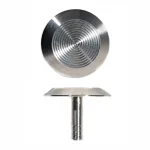Tactile Indicators
Ensure Safety and Accessibility with High-Quality Tactile Indicators
Securing safety and accessibility in public and industrial spaces is crucial for individuals with impaired vision. Tactile indicators offer a straightforward yet vital solution to help visually impaired individuals navigate complex environments confidently. At Sterling Supplies, we prioritise the creation of safe and inclusive spaces that adhere to regulations. That’s why we offer a range of high-performance, user-friendly tactile indicators in Melbourne, specifically designed to enhance accessibility for everyone.
Make Navigation Easier with High-Quality Tactile Indicators
In areas where foot traffic is high, and protection is paramount, reliable tactile indicators are crucial in minimising risks and enhancing the overall user experience. Safety tools, such as TGSI tactile and ground surface indicators, are used on stairs, ramps, and walkways to provide tactile cues for the visually impaired, ensuring everyone can move freely and safely.
Whether you’re managing a busy commercial space or an industrial facility, our tactile ground surface indicators are key to preventing accidents and promoting accessibility.
Explore the Range of Reliable Tactile Indicators We Provide:
- Individual Tactile Indicators: Durable and versatile options available in various materials, suitable for multiple applications.
- Integrated Tactile Indicators: Streamlined solutions for seamless installation and enhanced aesthetic appeal.
- Variety of Finishes: Choose from stainless steel, brass, or polymeric plastic for a look that complements your space and meets tactile indicators that align with Melbourne’s preferences.
- Compliance Ready: All tactile indicators meet Australian safety standards and ensure long-lasting performance.
What Sets Sterling Supplies Apart?
- Australian-owned family business
- High-quality, durable products
- Compliance with Australian AS/NZS 1428.4.1:2021 standards
- Easy and seamless ordering process
- Customisable solutions to suit specific requirements
- Suitable for various surfaces:( natural stone, engineering stone, concrete, timber vinyl flooring, and ceramic)
Don’t compromise on security. Ensure your public and industrial spaces are accessible and secure with TGSI tactiles from Sterling Supplies. Contact us today to learn more!
Product Categories

Individual Tactiles
Individual tactile indicators are powerful tools that provide tactile cues to aid individuals with visual impairments in navigating public spaces with confidence.

Integrated Tactiles
Integrated tactile indicators redefine how individuals with visual impairments experience public spaces.
Videos
PRICING GUIDE
Comprehensive listing of our products & prices

PRODUCT CATALOGUE
View details of our entire product range
FAQ
Tactile indicators are raised surfaces with distinct patterns that are used to assist individuals with visual impairments in navigating public spaces. They provide tactile and sensory cues, alerting people to changes in the environment, such as approaching hazards or directional changes.
At Sterling Supplies, we offer two types of tactile indicators: Individual Tactile Indicators and Integrated Tactile Indicators.
Individual Tactile Indicators are stand-alone units that can be installed individually or in combination to create tactile patterns. They are available in various materials and designs to suit different applications.
Our range of Individual Tactile Indicators includes tactile indicators with stem and peel and stick tactiles. Each type serves a specific purpose and can be selected based on your requirements
Our Tactile Indicators are available in a variety of materials, including stainless steel, brass, and polymeric options. These materials offer different benefits in terms of durability, aesthetics, and performance, allowing you to choose the most suitable material for your specific application.
Integrated Tactile Indicators are a type of tactile ground surface indicators (TGSI) that consist of a series of raised dots on a backing plate. They are installed as a complete unit on pedestrian surfaces, providing tactile cues and warnings to assist individuals with visual impairments in safely navigating the built environment
Our range of Integrated Tactile Indicators includes Stainless Steel Carpet Systems, Stainless Steel Plates and Polymeric Tactile Pads. These products are specifically designed for different environments and applications.
Yes, at Sterling Supplies, we prioritize the quality and compliance of our products. Our tactile indicators are designed and manufactured to meet the AS/NZS 1428.4.1:2009 standards for Design for Access and Mobility – Part 4.1: Means to Assist the Orientation of People with Vision Impairment.
Yes, we offer professional installation services for our tactile indicators. Our experienced team ensures precise installation, adhering to the recommended guidelines and best practices to ensure optimal functionality and longevity of the products.
To request our installation services, please contact our customer service team. They will guide you through the process, provide you with a detailed quotation, and schedule a convenient installation date based on your requirements.
Peel and stick tactile indicators are designed for easy installation. The adhesive backing allows for a simple peel-and-stick process. Clean and prepare the surface, peel off the protective backing, and firmly press the tactile indicator onto the desired location. Ensure that the surface is clean, dry, and free from any dust or debris for optimal adhesion
Peel and stick tactile indicators are generally intended for permanent installation. While they can be removed, reinstallation may not be as secure, and it is recommended to replace the indicators with new ones to ensure proper adhesion and functionality.
Yes, individual tactile indicators with stems can be installed on a variety of surfaces, including concrete, timber, tiles, and more. It is important to ensure that the substrate is suitable for installation and that the correct adhesive and fixing methods are used for each specific surface type.
While it is possible to install individual tactile indicators with stems on your own, we highly recommend professional installation to ensure accurate placement and proper adherence to installation guidelines. At Sterling Supplies, we have the necessary expertise and tools to ensure a precise and reliable installation.
Colour contrast plays a vital role in enhancing the visibility and effectiveness of tactile indicators. It ensures that individuals with visual impairments can easily differentiate and perceive the tactile indicators, providing them with essential information about their surroundings and potential hazards.
The recommended colour contrast requirements for tactile indicators are outlined in the AS/NZS 1428.4.1:2009 standards. According to the guidelines, there should be a minimum luminance contrast of 45% (for individual tactile indicators) and 30% (for Tactile Plates) between the tactile indicators and the background surface. This ensures sufficient visual distinction for individuals with varying levels of visual impairment.
At Sterling Supplies, we understand the importance of colour contrast for tactile indicators. To assist our customers in evaluating colour contrast, we provide the Light Reflectance Value (LRV) rating for all our tactile indicators. LRV indicates the relative lightness or darkness of a colour and helps assess the contrast between the tactile indicator and the background surface.
The LRV rating is specific to each tactile indicator. We provide the LRV rating as part of the product specifications, allowing you to compare and select the appropriate tactile indicators to meet your desired level of contrast.
The LRV rating is a numeric value that ranges from 0 (black) to 100 (white). By comparing the LRV rating of the tactile indicator with the LRV rating of the background surface, you can assess the contrast level. The greater the difference in LRV values, the higher the contrast and visibility of the tactile indicator.
Yes, in addition to providing LRV ratings, we offer on-site luminance testing services for our customers. Our experienced team can visit your location to conduct comprehensive luminance testing, ensuring that the colour contrast of the tactile indicators meets the necessary standards and requirements.
If you require on-site luminance testing services, please contact our customer service team to discuss your specific needs and project requirements.
